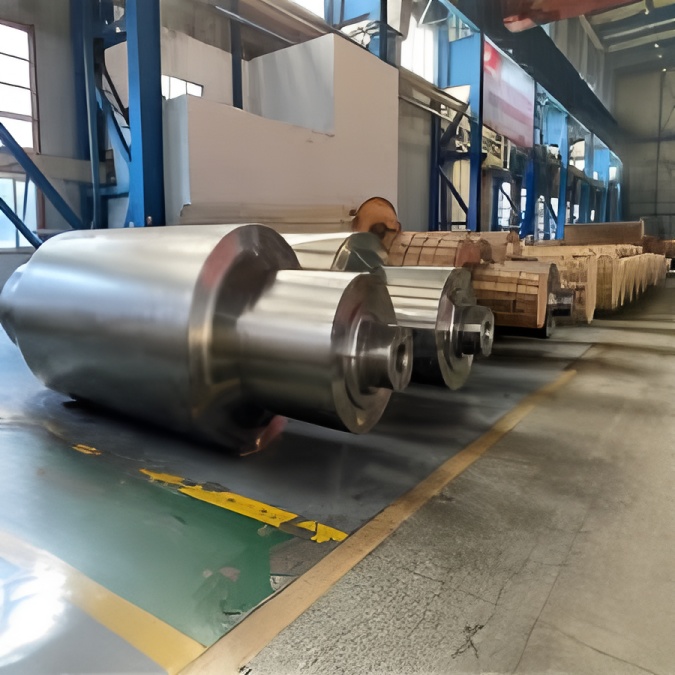What is a cast iron roll?
Cast iron rolls are categorized into: general cast iron rolls, high nickel chromium infinitely chilled cast iron rolls, chromium composite cast iron rolls, and nodular cast iron rolls.
General cast iron roll:
General cast iron rolls can be classified into chilled cast iron rolls, medium and low alloy infinitely chilled cast iron rolls, and medium and low alloy nodular cast iron rolls.
Chilled cast iron is a type of cast iron produced by utilizing the supercooling of the molten iron itself along with surface chilling via the mold. The surface of the roll body forms a chilled white layer, which provides high hardness and good wear resistance. Based on the production process and core materials, chilled cast iron rolls can be divided into three types: non-nodular iron, nodular composite, and spherical core.
The infinitely chilled cast iron roll is a material介于介于 chilled cast iron and gray cast iron. The matrix structure of the working layer contains graphite, and there is no clear boundary between the working layer and the core. These are considered lower-end rolls.
General cast iron roll application:
General cast iron rolls are mainly used as rolls in stacked sheet mills, Lauter plate mills, wire rod mills, bar mills, and section steel mills.
chill-rolls
High Ni-Cr Infinitely Chilled Cast Iron Rolls
Infinitely chilled cast iron is a material between chilled cast iron and gray cast iron. In infinitely chilled cast iron rolls, graphite is evenly distributed within the matrix of the working layer. The graphite content increases from the surface toward the interior, resulting in a gradual decrease in hardness.
Thus, there is no clear demarcation between the working layer and the core. This is why it is also called an unbounded chilled cast iron roll. When the roll material contains high levels of chromium, nickel, and molybdenum, it is referred to as a high nickel-chromium infinitely chilled cast iron roll. These rolls are produced via full flush (overflow method) or centrifugal composite casting processes.
Chromium Composite Cast Iron Rolls
Chromium composite cast iron rolls are made from high-chromium white wear-resistant iron containing 12% to 22% chromium. This material forms the outer layer of the roll body. Typically, nodular cast iron is used for the core and neck sections. These rolls are produced by centrifugal composite casting. The structure contains Cr7C3-type eutectic carbides, chrysanthemum-shaped Mo2C-type eutectic carbides, and granular Cr23C6-type secondary carbides, providing high wear resistance.
Application of chromium composite cast iron rolls:
Chromium composite cast iron rolls are widely used in hot strip continuous rolling mills, pre-finishing stands, roughing and finishing stands for light gauge plate, and small section steel mills.
Ductile cast iron roll
Since graphite is evenly distributed in spherical form from the surface to the core, ductile cast iron offers high tensile strength, the ability to withstand heavy loads, and good wear resistance. The matrix structure consists of carbides and pearlite or acicular structures. Based on the matrix structure of the roll body, ductile cast iron rolls can be divided into two categories: pearlitic ductile iron rolls and acicular ductile iron rolls.
Ductile iron rolls are typically produced through monolithic casting. However, due to higher casting stresses in needle-shaped ductile iron rolls with higher alloy content, the centrifugal composite casting process is often used to achieve ideal comprehensive properties.
Application of Ductile Cast Iron Rolls
These rolls offer good thermal shock and wear resistance, making them widely used in large section steel mills, continuous bar mills, and large seamless tube mills.
chill-rolls
Alloying Principle of Infinitely Chilled Cast Iron Rolls
C: High carbon content hinders the precipitation of cementite and increases the number of graphite nucleation sites, thereby refining the graphite. However, excessively high carbon can lead to graphite flotation. Under a fixed cooling rate, increasing carbon within a certain range reduces the white layer depth and increases surface carbides. Based on practical requirements, carbon content is typically set between 3.1% and 3.6%.
Si: Silicon reduces the solubility of carbon in austenite, raises the eutectoid transformation temperature, broadens the eutectoid transformation range, and shortens the incubation period for pearlite and bainite formation.
Within a certain range, increasing silicon content refines the graphite nodules. Silicon is controlled between 1.4% and 1.8%. Both carbon and silicon directly affect the overall performance of cast iron rolls.
Carbon and silicon should be considered together. The upper limit of carbon equivalent should avoid graphite flotation, while the lower limit should meet roll performance requirements and ensure an appropriate amount of carbide. Therefore, carbon equivalent is controlled between 3.9% and 4.4%.
Mn: Manganese lowers the eutectoid transformation temperature, helping to stabilize and refine pearlite. It improves the strength and hardness of the roll. However, excessive manganese causes severe segregation and precipitates grain boundary carbides in the as-cast state, reducing toughness. Content should be controlled between 0.4% and 0.8%.
Cr: Chromium is the most effective element for increasing the depth of the white layer in chilled cast iron rolls. It significantly counteracts the adverse effects of silicon and promotes the formation of pearlite.
In alloy ductile iron, appropriate chromium addition leads to the presence of free carbides, improving hardness and wear resistance. Chromium content is controlled between 0.2% and 0.4%.
Mo: Molybdenum stabilizes pearlite, refines the white layer structure in chilled iron, enhances material strength, and improves the thermal strength of the roll.
In alloy ductile iron rolls, increasing molybdenum content promotes pearlite formation and improves its dispersion. Molybdenum also inhibits austenite decomposition, facilitating bainite formation. However, due to its tendency to segregate, molybdenum content should not be too high and is usually controlled between 0.2% and 0.6%.
P, S: Phosphorus content should be controlled below 0.2%, and sulfur below 0.02%.


